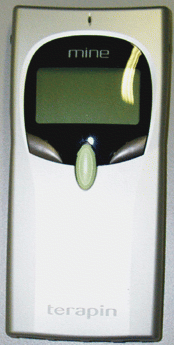Therapy for the Terapin Mine
Mar 29, 2004 — by LinuxDevices Staff — from the LinuxDevices Archive — 6 viewsForeword: This article describes a project to develop a free, open, alternative Linux distribution for the Terapin Mine, a small portable device that can function as a USB hard drive, MP3 player, or photo slide show viewer.
The Terapin Mine device looks like the half-giant version of the Apple iPod. The Mine is a Linux machine with Ethernet, PCMCIA, and USB master and slave connectivity. It comes with a 10GB harddrive and is based on the Motorola PowerPC 8xx processor series.
 Linux on the Terapin Mine uses the 2.2.14 kernel and glibc-2.1.3. In factory fresh condition, one can use this device as a portable HD, MP3 player, voice recorder and flash memory card reader (using a PCMCIA adapter) as well as a portable backup/storage solution. And, do not forget the slide show machine for digital images, through an attached TV or monitor.
Linux on the Terapin Mine uses the 2.2.14 kernel and glibc-2.1.3. In factory fresh condition, one can use this device as a portable HD, MP3 player, voice recorder and flash memory card reader (using a PCMCIA adapter) as well as a portable backup/storage solution. And, do not forget the slide show machine for digital images, through an attached TV or monitor.
In order to get access to a Linux console on the Mine, one has to use a software (crackmis.exe) running on a Windows machine, and the Mine software must have a system upgrade available from the Terapin Mine developer website. This website also offers some brief documentation on how to write PCMICA and USB drivers using an embedded linux development toolchain, be it 'home-grown' or from some vendor like MontaVista or denx.de.
In contrast to the PDA world, Terapin Mine does unfortunately not yet have an official alternative open distribution like Open Zaurus and OPIE for the Sharp Zaurus or Familiar for Compaq iPAQ. Fortunately, the Terapin Mine developer website makes some information available implicitly that may help to start such an effort. The available documentation reveals the following:
- The Mine kernel must have a setup similar to the RPX Lite board.
- There are tools to convert a Mine linux kernel (if you manage to cross-compile one) to Motorola's s-record format and finally to the binary format used by Terapin Mine.
- Unfortunately, the kernel source used in the Mine is not available on the developer website, but it has most probably been developed using Hardhat Linux from MontaVista (of course, the vanilla 2.2.14 kernel is at ftp.kernel.org, but developers need the patches and source code extensions used by Terapin in order to 'roll' their own distribution).
- Example plugins show the use of the Arawana's (internal name of the device and the Mine application that interacts with the user) library which is necessary to produce output on the LCD screen.
- The Terapin Mine developer website points to a free toolchain that allows developing software for the Mine. This toolchain has not been used to produce the Mine Linux system or the proprietory application that drives the MP3-HD-photo-download 'device' interface.
- There must be a way to use the video-out with Microwindows or Nano-X, which would be cool to make the Mine device, a keyboard, and a TV with video-in into a full computer with regular I/O. The Mine can do a slide show using video-out, and the developer references say that Microwindows can be ported even though some people reported problems on Terapin's developer forums for the Mine.
- – X. The possibilities are endless, but developers need some more information from Terapin's side for speeding up initial developments, otherwise people may loose interest because so many things have to be reverse engineered or re-created.
The available information does neither look complete or highly encouraging to start developing new applications or plugins right away, but it is enough to build a set of tools allowing development of programs and plugins for the Mine. It is also enough to port some missing or desirable console applications to this device.
I have collected my so far successful but not very coordinated efforts to do this on Website. I am not sure how many other people using the Mine have ported software so far, but I hope that this article will stir up interest and get some more coordinated efforts going to develop and port software for the Mine.
On the positive side: The Mine is a cool device, it has hundreds of uses, and is much more versatile than pure MP3-players or portable hard-drives. It runs a decent, extensible Linux system. The cross-compiler can be built with reasonable effort, and it is a lot of fun to get some real applications running on a machine that was primarily built to store and show pictures and play music.
This article was originally published on LinuxDevices.com and has been donated to the open source community by QuinStreet Inc. Please visit LinuxToday.com for up-to-date news and articles about Linux and open source.